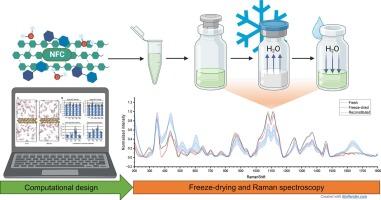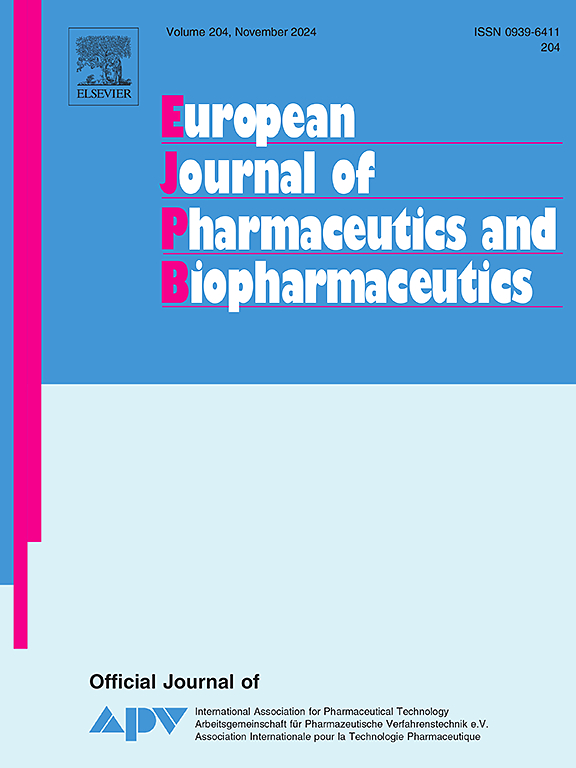Freeze-drying-induced mutarotation of lactose detected by Raman spectroscopy
IF 4.4
2区 医学
Q1 PHARMACOLOGY & PHARMACY
European Journal of Pharmaceutics and Biopharmaceutics
Pub Date : 2024-10-18
DOI:10.1016/j.ejpb.2024.114534
引用次数: 0
Abstract
Freeze-drying enables delicate, heat-sensitive biomaterials to be stored in a dry form even at room temperature. However, exposure to physicochemical stress induced by freeze-drying presents challenges for maintaining material characteristics and functionality upon reconstitution, for which reason excipients are required. Although wide variety of different excipients are available for pharmaceutical applications, their protective role in the freeze-drying is not yet fully understood. In this study, our aim was to use molecular dynamics simulations to screen the properties of different sugars and amino acids, which could be combined with plant-based nanofibrillated cellulose (NFC) hydrogel to provide protective matrix system for future freeze-drying for pharmaceuticals and biologics. The changes in the NFC-based formulations before and after freeze-drying and reconstitution were evaluated using non-invasive Timegate PicoRaman spectroscopy and traditional characterization methods. We continued to the freeze-drying with the NFC hydrogel formulations including lactose with and without glycine, which showed the highest attraction preferences on NFC surface in silico. This formulation enabled successful freeze-drying and subsequent reconstitution with preserved physicochemical and rheological properties. Raman spectroscopy gave us insights of the molecular-level changes during freeze-drying, especially the mutarotation of lactose. This research showed the potential of integrating in silico screening and non-invasive spectroscopical method to design novel biomaterial-based formulations for freeze-drying. The research provided insights of the molecular-level interactions and orientational changes of the excipients, which might be crucial in future freeze-drying applications of pharmaceuticals and biologics.

通过拉曼光谱检测冷冻干燥诱发的乳糖变异。
冷冻干燥技术可使易碎、对热敏感的生物材料在室温下也能以干燥的形式保存。然而,冷冻干燥引起的物理化学应力会给复溶时保持材料特性和功能带来挑战,因此需要辅料。虽然有多种不同的辅料可用于制药,但人们对它们在冻干过程中的保护作用还不完全了解。在这项研究中,我们的目的是利用分子动力学模拟来筛选不同糖类和氨基酸的特性,并将其与植物基纳米纤维素(NFC)水凝胶相结合,为未来的药物和生物制剂冻干提供保护基质系统。我们使用非侵入式 Timegate PicoRaman 光谱法和传统的表征方法评估了基于 NFC 的配方在冻干和重组前后的变化。我们继续使用 NFC 水凝胶配方进行冻干,其中包括含甘氨酸和不含甘氨酸的乳糖。这种配方能够成功进行冻干和随后的重组,并保持物理化学和流变特性。拉曼光谱让我们深入了解了冻干过程中分子水平的变化,特别是乳糖的变构。这项研究表明,将硅学筛选和非侵入性光谱方法结合起来,设计新型冻干生物材料制剂是很有潜力的。该研究提供了对辅料的分子级相互作用和取向变化的深入了解,这可能对未来药物和生物制剂的冷冻干燥应用至关重要。
本文章由计算机程序翻译,如有差异,请以英文原文为准。
求助全文
约1分钟内获得全文
求助全文
来源期刊
CiteScore
8.80
自引率
4.10%
发文量
211
审稿时长
36 days
期刊介绍:
The European Journal of Pharmaceutics and Biopharmaceutics provides a medium for the publication of novel, innovative and hypothesis-driven research from the areas of Pharmaceutics and Biopharmaceutics.
Topics covered include for example:
Design and development of drug delivery systems for pharmaceuticals and biopharmaceuticals (small molecules, proteins, nucleic acids)
Aspects of manufacturing process design
Biomedical aspects of drug product design
Strategies and formulations for controlled drug transport across biological barriers
Physicochemical aspects of drug product development
Novel excipients for drug product design
Drug delivery and controlled release systems for systemic and local applications
Nanomaterials for therapeutic and diagnostic purposes
Advanced therapy medicinal products
Medical devices supporting a distinct pharmacological effect.

 求助内容:
求助内容: 应助结果提醒方式:
应助结果提醒方式:


